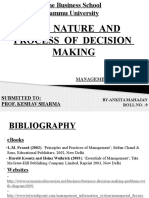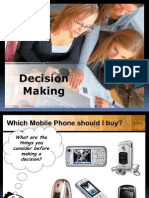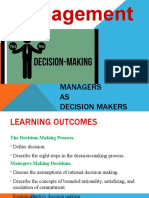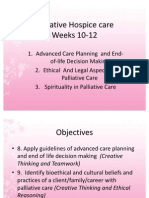10 Step Method of Decision Making
Uploaded by
padamvirsandu10 Step Method of Decision Making
Uploaded by
padamvirsanduTHE TEN STEP METHOD OF DECISION-MAKING Page 1 of 13
THE TEN-STEP METHOD OF DECISIONMAKING
BACKGROUND
Developed by Jon Pekel and Doug Wallace, the Ten Step Method of Decisionmaking has five features that
make it practically useful in today's highly competitive, global context, rapidly changing business
environment:
1. Stakeholder Based
¾ Based on the stakeholder theory of management – assumes that anyone or any
entity that could be significantly affected has a RIGHT to have its best interests
CONSIDERED
2. Ethical Theory Based
¾ Based on (and incorporates as a check-and-balance on one another) the two most
commonly used and beneficial ethical decision-making perspectives
¾ Consequential perspective focuses on the cost/benefit affects of the decision
¾ Absolute principle perspective focuses on aligning action with universal ethical
principles
3. Systems Based
¾ Probes for and deals with underlying drivers that cause and exacerbate the
situation.
¾ Doesn't just deal with "rotten apple issues in the barrel"
¾ Forces decisionmakers to also deal with the barrel (organizational culture and
systems) itself
4. Ethical Checklist
¾ Includes a simple checklist that gives the decisionmakers a numerical sense of
how effective they have been in using the ethical dimensions of the
decisionmaking process.
5. Designed To Be A Highly Practical Management Tool
¾ As the situation warrants, some or all of the ten steps can be used
¾ Recognizes that most serious, high-risk, high-impact issues stem from
management's actions or inactions
¾ Effective in dealing with highly complex situations, including cross-cultural
international business issues
¾ Also useful for non-management staff in raising and resolving ethical issues
c Jon Pekel (651-734-9011) & Doug Wallace (612-333-0520)
[Permission is granted for the non-publication organizational use of this Ten Step Method of DecisionMaking.]
file://C:\FML Feb 19 2006\ethics\long.htm 8/8/2006
THE TEN STEP METHOD OF DECISION-MAKING Page 2 of 13
THE TEN STEPS AT-A-GLANCE
[Includes hints for using each step]
[Before You Get Started: Do a Preliminary Ethical Assessment. Use 2 tests to determine
to what degree there is a significant ethical dimension to this situation.
1) Value-conflicts. How different are the kinds of values held by different stakeholders?
2) Consequences. How significant are the possible consequences of this situation?
1. IDENTIFY THE KEY FACTS
¾ “Role play” key stakeholders to see what they see as facts.
¾ Watch out for assuming causative relationships among coincidental facts.
2. IDENTIFY & ANALYZE THE MAJOR STAKEHOLDERS
¾ Make sure to identify both direct and indirect stakeholders.
¾ Genuinely “walk in their shoes” to see what they value and want as a desired outcome.
3. IDENTIFY THE UNDERLYING DRIVING FORCES
¾ Think like a M.D. – look for what’s beneath the presenting symptoms.
¾ Use these driving forces to develop your Step 8 preventive component.
4. IDENTIFY/PRIORITIZE OPERATING VALUES & ETHICAL PRINCIPLES
¾ Think of this step as determining the up-front “design parameters” for an effective solution.
¾ Don’t rush this step – building consensus here will pay off later.
5. DECIDE WHO SHOULD BE INVOLVED IN MAKING THE DECISION
¾ All stakeholders have a right to have their best interests considered.
¾ If you can’t actually involve all stakeholders, have someone “role play” their point of view.
6. DETERMINE & EVALUATE ALL VIABLE ALTERNATIVES
¾ Critical: all possible alternatives must pass the 3-part review-gate criteria.
¾ Imagine possible consequences of each alternative cascading down on each stakeholder.
7. TEST PREFERRED ALTERNATIVE WITH A WORST-CASE SCENARIO
¾ This step helps prevent a “rush to judgment” towards a wrong solution.
¾ Emphasize this step when all stakeholder interests are not being adequately considered.
8. ADD A PREVENTIVE COMPONENT
¾ “Problem-solving heroes” want to get on to the next problem and won’t take time for this step.
¾ Only immediate-solution decisions usually come back to bite you.
9. DECIDE AND BUILD A SHORT & LONG-TERM ACTION-PLAN
¾ The devil’s usually in the details – take the time needed to be detailed and comprehensive.
¾ Make sure that the means used in your action-steps correlate with your desired ends.
10. USE DECISION-MAKING CHECKLIST
¾ Become thoroughly familiar with this end-point checklist before you get started in Step 1.
¾ Don’t allow group-think here -- make sure everyone involved fills this out individually.
file://C:\FML Feb 19 2006\ethics\long.htm 8/8/2006
THE TEN STEP METHOD OF DECISION-MAKING Page 3 of 13
BEFORE YOU GET STARTED: DO A PRELIMINARY ETHICAL ASSESSMENT
Background. An ethical business issue is any significant business issue that has a significant ethical dimension.
There are two tests to decide whether a business issue has a significant ethical dimension. If one or both apply, the
situation requires use of an ethically based decision-making process like this Ten Step Method. The two-fold test is
whether situation could possibly cause the business to knowingly or unknowingly:
1) Violate a commonly accepted ethical principle (e.g. honesty, fairness, respect for persons) or stated
business standard (e.g. no conflicts of interest or misuse of corporate funds.) This definition is rooted in the
non-consequentialist, universal/absolute principle, or rule-oriented ethical perspective.
2) Inflict significant, undue, inappropriate harm on any stakeholder. A stakeholder is any individual,
group, society or the natural environment that could be effected by the situation. This definition is rooted in
the consequentialist, effects, or results-oriented ethical perspective.
TEST #1: DEGREE OF COMPETING VALUE-CONFLICTS -- How different are the kinds of ethical principles and
operating values held by different stakeholders? Typically, the strongest value conflicts are between operating
values (e.g. make a profit) and ethical principles (e.g. honesty). List below some of the different kinds of operating
values and ethical principles/business standards that are in conflict with one another in this situation:
1) [Operating value] vs. [Principle/standard]
2) [Operating value] vs. [Principle/standard]
Check the box that represents the degree of value-conflicts in this situation:
CHECK DEGREE OF VALUE-CONFLICT RATING SCALE:
In This Situation, The Kinds Of Values Held By Different Stakeholders Are . . .
5. Extremely different
4. Very different
3. Somewhat different
2. Not very different
1. No major value-conflict differences in this situation
TEST #2: EXTENT OF POSSIBLE HARMFUL CONSEQUENCES -- How significant are the possible harmful
consequences of this situation? Consequences can be direct, 1st order consequences or indirect, 2nd and 3rd order
consequences. List below the possible harmful consequences in this situation:
1) [Possible harmful consequence]
2) [Possible harmful consequence]
Check the number that represents the degree of consequences in this situation:
CHECK EXTENT OF POSSIBLE HARMFUL CONSEQUENCES RATING SCALE:
In This Situation, The Possible Harmful Consequences Are . . .
5. Extremely significant
4. Very significant
3. Somewhat significant
2. Not very significant
1. No significant possible harmful consequences in this situation
NOW, TABULATE YOUR RESULTS. Total the checked numbers from the above 2 tests and check the appropriate
range on the scale below:
CHECK TOTALS OVERALL RATING SCALE:
The Ethical Dimension Of This Situation Is . . .
10 Extremely significant – DEFINITELY use the Ten Step Method of Decision-Making
8-9 Very significant – DEFINITELY use the Ten Step Method of Decision-Making
6-7 Somewhat significant – SHOULD use the Ten Step Method of Decision-Making
4-5 Not very significant – PROBABLY use the Ten Step Method of Decision-Making
1–3 Not at all significant – No need to use the Ten Step Method of Decision-Making
[Consider these answers when determining your decision and action-plan.]
file://C:\FML Feb 19 2006\ethics\long.htm 8/8/2006
THE TEN STEP METHOD OF DECISION-MAKING Page 4 of 13
STEP ONE: IDENTIFY THE KEY FACTS
List below the most important known facts in the situation:
1.
2.
3.
4.
5.
6.
7.
8.
9.
10.
11.
12.
What else do you need to know to better understand the total situation?
1.
2.
3.
[Consider these answers when determining your decision and action-plan.]
file://C:\FML Feb 19 2006\ethics\long.htm 8/8/2006
THE TEN STEP METHOD OF DECISION-MAKING Page 5 of 13
STEP TWO: IDENTIFY & ANALYZE THE MAJOR STAKEHOLDERS
List below the major stakeholders (individuals, groups, institutions, etc.) that have a stake in the outcome of the
situation. Using “moral imagination” put yourself in their place (walk in their shoes) and identify the key values they
would bring to this situation and the desired outcomes they would want from this situation.
MAJOR STAKEHOLDERS WHAT THEY VALUE THEIR DESIRED OUTCOMES
1.
2.
3.
4.
5.
6.
7.
Stakeholder Values Analysis
What stakeholder values are the most competing and most different from one another?
[Stakeholder value] vs. [Stakeholder value]
[Stakeholder value] vs. [Stakeholder value]
What are the most shared values among all or most of the stakeholders? [Win/win solutions can be crafted out of
these shared values.]
[Shared value] [Shared Value]
[Shared value] [Shared Value]
[Consider these answers when determining your decision and action-plan.]
file://C:\FML Feb 19 2006\ethics\long.htm 8/8/2006
THE TEN STEP METHOD OF DECISION-MAKING Page 6 of 13
STEP THREE: IDENTIFY THE UNDERLYING DRIVING FORCES
List below the major underlying driving forces creating or exacerbating the situation. Then, describe how each driver
is creating or exacerbating the situation. Finally, list what changes in these drivers could help prevent similar
situations in the future. Make sure these ideas are included in the preventive component in Step Eight.
MAJOR DRIVER HOW IS IT CREATING OR WHAT CHANGES COULD HELP
EXACERBATING THE SITUATION? PREVENT FUTURE SITUATIONS?
1.
2.
3.
4.
5.
6.
7.
[Consider these answers when determining your decision and action-plan.]
file://C:\FML Feb 19 2006\ethics\long.htm 8/8/2006
THE TEN STEP METHOD OF DECISION-MAKING Page 7 of 13
STEP FOUR: IDENTIFY/PRIORITIZE OPERATING VALUES & ETHICAL PRINCIPLES
1. List below both the operating values and ethical principles relevant to the situation that should be upheld in your
decision and action-plan.
¾ An operating value is any value needed to run the organization successfully -- e.g. make a profit or stay
within budget, don’t lose key customers, maintain employee morale, or “get the product out the door on
time, within cost, and without defects”, etc.
¾ An ethical principle is a widely recognized standard of human behavior – e.g. honesty, fairness, justice, or
respect for the dignity of persons or the environment, etc.
2. Place an X in the appropriate column indicating whether what you listed is an operating value and/or an ethical
principle. [Sometimes the item can be both an operating value and an ethical principle; for example, when
respect for the environment is an institutionalized operating value.]
3. In the far right column, priority rank all operating values and ethical principles by placing a 1 next to the highest
priority operating value or ethical principle that should be upheld in your decision and action-plan; a 2 next to the
second highest priority operating value or ethical principle. Continue ranking.
LIST BELOW BOTH OPERATING VALUES & ETHICAL PRINCIPLES Operating Ethical PRIORITY
Value Principle RANKING
RELEVANT TO THIS SITUATION [Check] [Check] [1 = highest]
a)
b)
c)
d)
e)
f)
g)
h)
i)
j)
k)
Stakeholder Values/Principles Agreement Index
Check below the degree of agreement you think there is among the stakeholders with your combined priority ranking
list of operating values and ethical principles.
Great agreement Some agreement Little agreement Virtually no agreement
How could you increase or maintain the agreement throughout the decision-making process?
[Consider these answers when determining your decision and action-plan.]
file://C:\FML Feb 19 2006\ethics\long.htm 8/8/2006
THE TEN STEP METHOD OF DECISION-MAKING Page 8 of 13
STEP FIVE: DECIDE WHO SHOULD BE INVOLVED IN THIS PROCESS
List below the individuals, groups, or institutions that should definitely have input into the decision and action-plan for
this situation. Then, indicate how you will obtain this input. [Note, because of limited time or to protect
confidentiality, in some cases you may need to have someone in a decision-making position “role play” input from
this stakeholder rather than to receive it directly from that stakeholder.] Next, list who should develop the decision
and action-plan. Finally, list who should actually make or approve the decision and action-plan.
WHO SHOULD HAVE INPUT TO THIS HOW COULD THIS INPUT BE OBTAINED?
DECISION AND ACTION-PLAN?
1.
2.
3.
4.
5.
6.
WHO SHOULD BE INVOLVED IN DEVELOPING THE RECOMMENDED DECISION & ACTION-PLAN?
1.
2.
3.
4.
5.
6.
WHO SHOULD ACTUALLY MAKE OR APPROVE THE FINAL DECISION & ACTION-PLAN?
1.
2.
3.
[Consider these answers when determining your decision and action-plan.]
file://C:\FML Feb 19 2006\ethics\long.htm 8/8/2006
THE TEN STEP METHOD OF DECISION-MAKING Page 9 of 13
STEP SIX: DETERMINE & EVALUATE ALL VIABLE ALTERNATIVES
1. Quickly brainstorm a list of possible alternative solutions to this situation.
Alternative 1 Alternative 2 Alternative 3 Alternative 4
Alternative 5 Alternative 6 Alternative 7 Alternative 8
2. Next, evaluate all alternatives using the three below listed review-gate criteria. Only those alternatives that meet
all 3 criteria become viable alternatives.
3. Now, list the major stakeholders identified in Step 2 down the far left hand column. Then, fill in the most
important possible consequences of each viable alternative on each stakeholder.
4. Finally, after having reviewed your list of consequences on each stakeholder, select your preferred viable
alternative.
REVIEW-GATE CRITERIA FOR AN EFFECTIVE DECISION & ACTION-PLAN
List below only alternatives that meet all three of these criteria:
One. Prevents or minimizes harm to the major stakeholders listed in Step 2
Two. Upholds the combined prioritized list of operating values and ethical principles from Step 4
Three. Is a good, workable solution to the situation that can actually be implemented.
Viable Alternative #1 Viable Alternative #2 Viable Alternative #3 Viable Alternative #4
STAKEHOLDERS POSSIBLE CONSEQUENCES OF EACH ALTERNATIVE ON EACH STAKEHOLDER
1.
2.
3.
4.
5.
6.
7.
The Preferred Alternative Is Viable Alternative #
[Consider these answers when determining your decision and action-plan.]
file://C:\FML Feb 19 2006\ethics\long.htm 8/8/2006
THE TEN STEP METHOD OF DECISION-MAKING Page 10 of 13
STEP SEVEN: TEST PREFERRED ALTERNATIVE WITH A WORST-CASE SCENARIO
1. Summarize your preferred viable alternative selected in Step 6 in the box provided.
2. Create in your mind and briefly describe below a worst-case scenario that assumes that if something can go
wrong during the implementation of your preferred alternative, it probably will go wrong!
3. Once again, in the far left column copy the list of major stakeholders from Step 2.
4. Think through and list the consequences of your worst-case scenario on each of your stakeholders. Include
other consequences that may not directly relate to a particular stakeholder.
5. Finally, assign a percent likelihood that this worst-case scenario could actually happen. Then, check the degree
of concern this percentage gives you. If needed, revise your preferred viable alternative or select another viable
alternative.
Brief description of your preferred viable alternative:
Brief description of your worst-case scenario:
STAKEHOLDERS CONSEQUENCES OF WORST CASE SCENARIO ON KEY EACH STAKEHOLDER
1.
2.
3.
4.
5.
6.
7.
OTHER CONSEQUENCES NOT DIRECTLY RELATED TO PARTICULAR STAKEHOLDERS
1.
2.
3.
4.
Worst-Case Scenario Probability Assessment
What is the percent likelihood that this worst-case scenario could actually happen? %
Check the degree of concern this percentage gives you about your preferred alternative:
No concern Some concern Substantial concern Critical concern
[Consider these answers when determining your decision and action-plan.]
file://C:\FML Feb 19 2006\ethics\long.htm 8/8/2006
THE TEN STEP METHOD OF DECISION-MAKING Page 11 of 13
STEP EIGHT: ADD A PREVENTIVE COMPONENT
Now, take your preferred alternative (possibly revised based on your worst-case scenario analysis) and add some
action-steps that would help prevent the situation from happening again. [Usually preferred alternatives only focus
on solving the immediate problem at hand. For ideas on this component, return to Step 3 where you listed the
underlying driving forces affecting the situation.
ACTION-STEPS THAT COULD PREVENT THE SITUATION FROM HAPPENING AGAIN
1.
2.
3.
4.
5.
6.
7.
[Consider these answers when determining your decision and action-plan.]
file://C:\FML Feb 19 2006\ethics\long.htm 8/8/2006
THE TEN STEP METHOD OF DECISION-MAKING Page 12 of 13
STEP NINE: DECIDE AND BUILD A SHORT & LONG-TERM ACTION-PLAN
List below your decision and action-steps in two parts – short-term, immediate and longer-term, preventive .
SHORT-TERM, IMMEDIATE-SOLUTION DECISION & OVERALL STRATEGY
ACTION-STEPS TO IMPLEMENT THE SHORT-TERM, IMMEDIATE-SOLUTION DECISION & STRATEGY
1.
2.
3.
4.
5.
6.
7.
8.
LONGER-TERM, PREVENTIVE-SOLUTION DECISION & OVERALL STRATEGY
ACTION-STEPS TO IMPLEMENT THE LONGER-TERM, PREVENTIVE-SOLUTION DECISION & STRATEGY
1.
2.
3.
4.
5.
6.
Ethical Justification
List three reasons why you think your comprehensive decision and action-steps are ethically justified:
1.
2.
3.
[Consider these answers when determining your decision and action-plan.]
file://C:\FML Feb 19 2006\ethics\long.htm 8/8/2006
THE TEN STEP METHOD OF DECISION-MAKING Page 13 of 13
STEP TEN: USE DECISION-MAKING CHECKLIST
Using the 0 through 6 scale, evaluate your immediate and preventive-solution decisions and action-steps against the
following eight tests. Tab over and place an “X” in the most appropriate column. Then, total all answers,check the
appropriate Decision-Making Confidence Scale, and follow the suggested actions.
RATING SCALE
EFFECTIVE DECISION-MAKING TESTS Not At All Å-------------Æ Totally Yes
0 1 2 3 4 5 6
1. Relevant Information Test. Have we obtained as much
information as possible to make an informed decision and
action-plan for this situation?
2. Involvement Test. Have we involved as many as possible
of those who have a right to have input to, or actual
involvement in, making this decision and action-plan?
3. Consequentialist Test. Have we attempted to
accommodate for the consequences of this decision and
action-plan on any who could be significantly affected by it?
4. Ethical Principles Test. Does this decision and action-plan
uphold the ethical principles that we think are relevant to this
situation?
5. Fairness Test. If we were any one of the stakeholders in
this situation, would we perceive this decision and action-
plan to be fair, given all of the circumstances?
6. Universality Test. Would we want this decision and action-
plan to become “universal law” so it would be applicable to all
– including ourselves – in similar situations?
7. Preventive Test. Does this decision and action-plan prevent
or minimize similar situations from happening again?
8. Light-Of-Day (or 60 Minutes TV Program) Test. Can our
decision and action-plan – including how we made it – stand
the test of broad-based public disclosure so everyone would
know everything about our actions?
Effective Decision-Making Confidence Scale
What is the total of all of your checked numbers? Now, check the box representing the appropriate
range. If needed, revise your decision and action-plan.
CHECK TOTALS HOW CONFIDENT CAN YOU BE
RANGE OF HAVING DONE AN EFFECTIVE JOB OF DECISION-MAKING?
44 - 48 Extremely confident – Do not need to revise your decision.
39 - 43 Very confident – Do not need to revise your decision.
33 - 38 Somewhat confident – Should revise your decision.
24 - 32 Not very confident – Definitely revise your decision.
0 - 23 Not at all confident – Definitely redo your entire analysis
file://C:\FML Feb 19 2006\ethics\long.htm 8/8/2006
You might also like
- The Risk Management Process: Jyothi/Frm/Sfcw100% (1)The Risk Management Process: Jyothi/Frm/Sfcw40 pages
- Bcom Iv Sem - Business Decisions Unit 01 What Is Decision?: Managerial Decision Making ProcessNo ratings yetBcom Iv Sem - Business Decisions Unit 01 What Is Decision?: Managerial Decision Making Process4 pages
- Week 3 - EnGG 406 - Decision Making - CorrectedNo ratings yetWeek 3 - EnGG 406 - Decision Making - Corrected47 pages
- 8 Steps in Decision Making Process - Docx 1No ratings yet8 Steps in Decision Making Process - Docx 113 pages
- Organizational Behavior Managing People and Organizations 11th Edition Griffin Solutions Manual - PDF Version Is Available For Instant Access100% (2)Organizational Behavior Managing People and Organizations 11th Edition Griffin Solutions Manual - PDF Version Is Available For Instant Access49 pages
- Akash Doklan BBA 6th Sem (Strategic Management)No ratings yetAkash Doklan BBA 6th Sem (Strategic Management)16 pages
- SU 5 Ethical decision-making and solving ethical dilemmas PART A _5_ _1_No ratings yetSU 5 Ethical decision-making and solving ethical dilemmas PART A _5_ _1_24 pages
- Instant Download for Organizational Behavior Managing People and Organizations 11th Edition Griffin Solutions Manual 2024 Full Chapters in PDF100% (23)Instant Download for Organizational Behavior Managing People and Organizations 11th Edition Griffin Solutions Manual 2024 Full Chapters in PDF49 pages
- Janis Birkeland - Net-Positive Design and Sustainable Urban Development-Routledge (2020)No ratings yetJanis Birkeland - Net-Positive Design and Sustainable Urban Development-Routledge (2020)409 pages
- Strategic Environmental Assessment The State of The ArtNo ratings yetStrategic Environmental Assessment The State of The Art11 pages
- Unit-I: Meaning of Test, Measurement and Evaluation50% (2)Unit-I: Meaning of Test, Measurement and Evaluation14 pages
- Facilitating Effective Project Meetings-2007 PMI Global Congres2sNo ratings yetFacilitating Effective Project Meetings-2007 PMI Global Congres2s10 pages
- Hink Wice: Harnessing The Power of CounterintuitionNo ratings yetHink Wice: Harnessing The Power of Counterintuition9 pages
- Learning Activity 2. Decision-Making ProcessNo ratings yetLearning Activity 2. Decision-Making Process8 pages
- Understanding Urban Geography Through Different Philosophical PerspectivesNo ratings yetUnderstanding Urban Geography Through Different Philosophical Perspectives3 pages
- T-107 Management Information SystemDevendra Jaiswal New 2023-2025No ratings yetT-107 Management Information SystemDevendra Jaiswal New 2023-20257 pages
- Thai Real Estate Practitioners Template-BERACNo ratings yetThai Real Estate Practitioners Template-BERAC17 pages
- Full download Good Thinking Seven Powerful Ideas That Influence the Way We Think 2nd Edition Cummins pdf docx100% (3)Full download Good Thinking Seven Powerful Ideas That Influence the Way We Think 2nd Edition Cummins pdf docx40 pages
- (C) CCE-UPES. Quantitative Techniques For Management Applications MBCQ-721D. UNIT 20 - Case StudyNo ratings yet(C) CCE-UPES. Quantitative Techniques For Management Applications MBCQ-721D. UNIT 20 - Case Study384 pages
- Guidelines For Historic Bridge Rehabilitation and Replacement100% (1)Guidelines For Historic Bridge Rehabilitation and Replacement66 pages
- Bcom Iv Sem - Business Decisions Unit 01 What Is Decision?: Managerial Decision Making ProcessBcom Iv Sem - Business Decisions Unit 01 What Is Decision?: Managerial Decision Making Process
- Organizational Behavior Managing People and Organizations 11th Edition Griffin Solutions Manual - PDF Version Is Available For Instant AccessOrganizational Behavior Managing People and Organizations 11th Edition Griffin Solutions Manual - PDF Version Is Available For Instant Access
- SU 5 Ethical decision-making and solving ethical dilemmas PART A _5_ _1_SU 5 Ethical decision-making and solving ethical dilemmas PART A _5_ _1_
- Instant Download for Organizational Behavior Managing People and Organizations 11th Edition Griffin Solutions Manual 2024 Full Chapters in PDFInstant Download for Organizational Behavior Managing People and Organizations 11th Edition Griffin Solutions Manual 2024 Full Chapters in PDF
- Janis Birkeland - Net-Positive Design and Sustainable Urban Development-Routledge (2020)Janis Birkeland - Net-Positive Design and Sustainable Urban Development-Routledge (2020)
- Strategic Environmental Assessment The State of The ArtStrategic Environmental Assessment The State of The Art
- Unit-I: Meaning of Test, Measurement and EvaluationUnit-I: Meaning of Test, Measurement and Evaluation
- Facilitating Effective Project Meetings-2007 PMI Global Congres2sFacilitating Effective Project Meetings-2007 PMI Global Congres2s
- Hink Wice: Harnessing The Power of CounterintuitionHink Wice: Harnessing The Power of Counterintuition
- Understanding Urban Geography Through Different Philosophical PerspectivesUnderstanding Urban Geography Through Different Philosophical Perspectives
- T-107 Management Information SystemDevendra Jaiswal New 2023-2025T-107 Management Information SystemDevendra Jaiswal New 2023-2025
- Full download Good Thinking Seven Powerful Ideas That Influence the Way We Think 2nd Edition Cummins pdf docxFull download Good Thinking Seven Powerful Ideas That Influence the Way We Think 2nd Edition Cummins pdf docx
- (C) CCE-UPES. Quantitative Techniques For Management Applications MBCQ-721D. UNIT 20 - Case Study(C) CCE-UPES. Quantitative Techniques For Management Applications MBCQ-721D. UNIT 20 - Case Study
- Guidelines For Historic Bridge Rehabilitation and ReplacementGuidelines For Historic Bridge Rehabilitation and Replacement

























































































